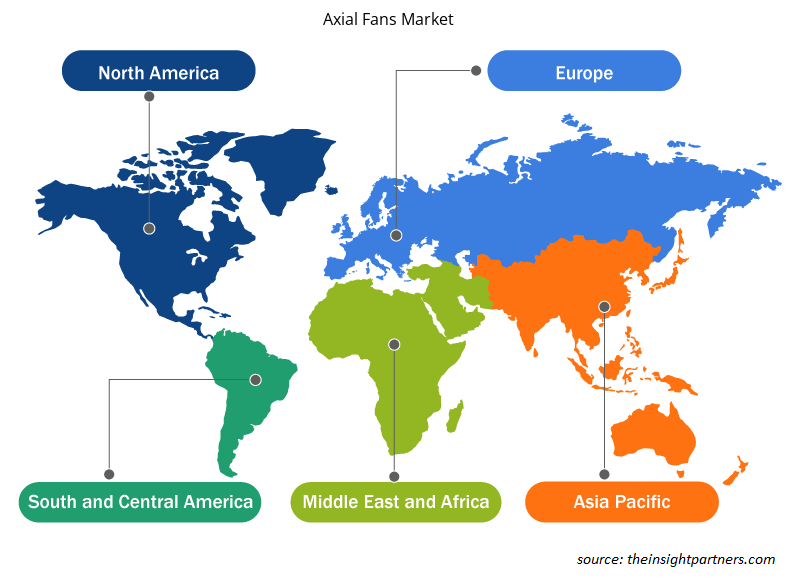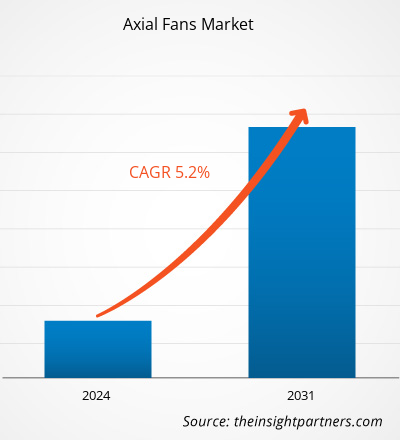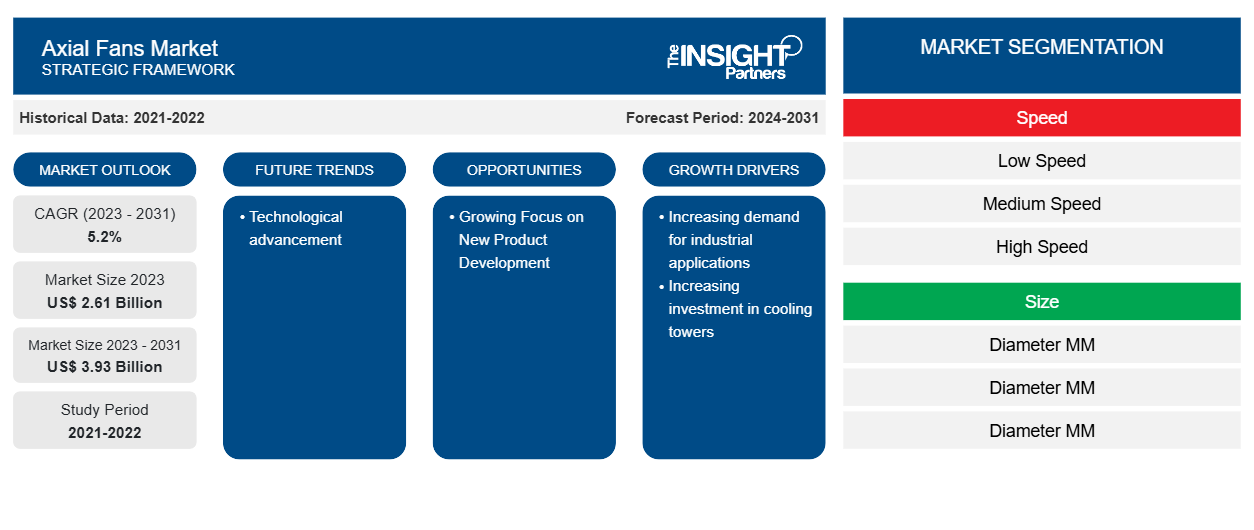Se proyecta que el mercado de ventiladores axiales crecerá de US$ 2.61 mil millones en 2023 a US$ 3.93 mil millones en 2031; se espera que se expanda a una CAGR del 5,2% entre 2023 y 2031. Se anticipa que el avance tecnológico será una tendencia clave en el mercado.CAGR of 5.2% from 2023 to 2031. Technological advancement is anticipated to be a key trend in the market.
Análisis del mercado de ventiladores axiales
Los ventiladores axiales son ideales para sistemas de calefacción, ventilación y aire acondicionado. Varias propiedades definen a los ventiladores axiales. Ejemplos de estas cualidades son un diámetro grande , un ancho radial estrecho y un diseño de perfil bajo. Estas características específicas contribuyen al alto rendimiento de los ventiladores de flujo axial. Los ventiladores de flujo axial también se utilizan ampliamente en la industria. Los ventiladores axiales pueden extraer aire de filtros rotativos y zanjas de aire de retorno. También se pueden utilizar como escape. Debido a todas estas ventajas, se espera que la demanda de ventiladores axiales crezca durante el período de pronóstico.
Descripción general del mercado de ventiladores axiales
Un ventilador axial es un ventilador que permite que el gas fluya a través de él en una dirección axial, paralela al eje alrededor del cual se mueven las aspas. El flujo es axial en la entrada y la salida. El ventilador está diseñado para producir una diferencia de presión y, por lo tanto, una fuerza, que provoca un flujo a través del ventilador. Los ventiladores axiales son ideales para generar un flujo de aire de gran volumen en sistemas de baja presión. Los ventiladores axiales están disponibles en varios tamaños y se pueden colocar en una placa de montaje grande o en un radio pequeño. Los radios cortos son los más predominantes y dan como resultado un flujo laminar, mientras que el montaje vertical, en la pared, en el techo y otros métodos proporcionan un flujo laminar suave.
Personalice este informe según sus necesidades
Obtendrá personalización en cualquier informe, sin cargo, incluidas partes de este informe o análisis a nivel de país, paquete de datos de Excel, así como también grandes ofertas y descuentos para empresas emergentes y universidades.
-
Obtenga las principales tendencias clave del mercado de este informe.Esta muestra GRATUITA incluirá análisis de datos, desde tendencias del mercado hasta estimaciones y pronósticos.
Impulsores del mercado y oportunidades de los ventiladores axiales
Creciente demanda de aplicaciones industriales para favorecer el crecimiento del mercado.
Los ventiladores axiales industriales son dispositivos mecánicos que transportan aire u otros gases en varias aplicaciones industriales. Funcionan haciendo girar un rotor o impulsor central a altas velocidades, lo que da como resultado un flujo de aire o gas dirigido a través de una serie de paletas o álabes. Este flujo se puede utilizar para ventilar, enfriar o hacer circular el aire en una variedad de entornos industriales, según las necesidades específicas de la aplicación. Los ventiladores axiales son populares en una variedad de aplicaciones. Son extremadamente eficientes y ahorran energía. También hacen menos ruido que los ventiladores centrífugos. Las aspas de los ventiladores axiales pueden ser curvadas o inclinadas. Los ventiladores axiales se pueden adaptar para satisfacer una variedad de necesidades. Por lo tanto, se espera que la demanda de ventiladores axiales para aplicaciones industriales crezca durante el período de pronóstico.
Creciente enfoque en el desarrollo de nuevos productos
Los principales participantes del mercado se están centrando en el desarrollo de nuevos productos y en el avance tecnológico. Se espera que esto genere perspectivas de crecimiento lucrativas para el crecimiento del mercado de ventiladores axiales durante el período de pronóstico. Por ejemplo, en septiembre de 2023, Mainstream, un conocido fabricante de ventiladores y serpentines para unidades de tratamiento de aire, anunció el lanzamiento de sus nuevos ventiladores axiales IntelliCUBE. Mainstream está fortaleciendo su posición como líder de la industria de HVAC, continuando la tradición de una empresa familiar de tres generaciones. Además, en septiembre de 2022, ebm-papst lanzó un novedoso ventilador axial para aplicaciones ferroviarias con alta contrapresión.IntelliCUBE Axial Fans. Mainstream is strengthening its position as an HVAC industry leader, carrying on the tradition of a three-generation family business. Further, in September 2022, ebm-papst launched a novel axial fan for railway applications with high back pressure.
Análisis de segmentación del informe de mercado de ventiladores axiales
Los segmentos clave que contribuyeron a la derivación del análisis del mercado de ventiladores axiales son la velocidad, el tamaño, la aplicación, el tipo y el usuario final.
- Por velocidad, el mercado está segmentado en baja velocidad, velocidad media y alta velocidad.
- Según el tamaño, el mercado se divide en diámetro (130-250) MM, diámetro (250-910) MM, diámetro (910-1500) MM y diámetro superior a 1500 MM.
- Según la aplicación, el mercado está segmentado en radiadores, refrigeración y enfriamiento, ventilación y otros.
- Según el tipo, el mercado está segmentado en CA, CC y CE.
- Según los usuarios finales, el mercado se divide en comercial, industrial y residencial.
Análisis de la cuota de mercado de ventiladores axiales por geografía
Según la región, el mercado está segmentado en América del Norte, Europa, Asia Pacífico, Medio Oriente y África, y América del Sur y Central.
Se espera que Asia Pacífico tenga una participación destacada en el mercado de ventiladores axiales durante el período de pronóstico. Este crecimiento puede atribuirse a la creciente demanda de aplicaciones industriales y comerciales. También se espera que América del Norte tenga una participación significativa del mercado en 2023. Se espera que el rápido ritmo de los desarrollos tecnológicos y las regulaciones gubernamentales de apoyo impulsen la demanda de ventiladores axiales de la región de América del Norte durante el período de pronóstico.
Perspectivas regionales del mercado de ventiladores axiales
Los analistas de Insight Partners explicaron en detalle las tendencias y los factores regionales que influyen en el mercado de ventiladores axiales durante el período de pronóstico. Esta sección también analiza los segmentos y la geografía del mercado de ventiladores axiales en América del Norte, Europa, Asia Pacífico, Oriente Medio y África, y América del Sur y Central.

- Obtenga datos regionales específicos para el mercado de ventiladores axiales
Alcance del informe de mercado de ventiladores axiales
| Atributo del informe | Detalles |
|---|---|
| Tamaño del mercado en 2023 | US$ 2.61 mil millones |
| Tamaño del mercado en 2031 | US$ 3.93 mil millones |
| CAGR global (2023 - 2031) | 5,2% |
| Datos históricos | 2021-2022 |
| Período de pronóstico | 2024-2031 |
| Segmentos cubiertos |
Por velocidad
|
| Regiones y países cubiertos |
América del norte
|
| Líderes del mercado y perfiles de empresas clave |
|
Densidad de actores del mercado de ventiladores axiales: comprensión de su impacto en la dinámica empresarial
El mercado de ventiladores axiales está creciendo rápidamente, impulsado por la creciente demanda de los usuarios finales debido a factores como la evolución de las preferencias de los consumidores, los avances tecnológicos y una mayor conciencia de los beneficios del producto. A medida que aumenta la demanda, las empresas amplían sus ofertas, innovan para satisfacer las necesidades de los consumidores y aprovechan las tendencias emergentes, lo que impulsa aún más el crecimiento del mercado.
La densidad de actores del mercado se refiere a la distribución de las empresas o firmas que operan dentro de un mercado o industria en particular. Indica cuántos competidores (actores del mercado) están presentes en un espacio de mercado determinado en relación con su tamaño o valor total de mercado.
Las principales empresas que operan en el mercado de ventiladores axiales son:
- Rosenberg Ventilatoren GmbH
- Ventiladores Sofasco
- Sunonwealth Industria de máquinas eléctricas Co., Ltd.
- Ziehl-Abegg
- Corporación Omron
- Hidria
Descargo de responsabilidad : Las empresas enumeradas anteriormente no están clasificadas en ningún orden particular.

- Obtenga una descripción general de los principales actores clave del mercado de ventiladores axiales
Noticias y desarrollos recientes del mercado de ventiladores axiales
El mercado de ventiladores axiales se evalúa mediante la recopilación de datos cualitativos y cuantitativos a partir de investigaciones primarias y secundarias, que incluyen publicaciones corporativas importantes , datos de asociaciones y bases de datos. A continuación, se enumeran algunos de los avances en el mercado de ventiladores axiales:
- Aerosystems, una marca líder en el diseño y fabricación de sistemas de ventilación, amplió las opciones de tamaño de su popular serie AXIAL Fan. El nuevo AXIAL FAN, número de pieza 7010000, es un dispositivo de ventilación y refrigeración desarrollado originalmente para la aplicación de ECS de aeronaves. (Fuente: Aerosystems, comunicado de prensa, diciembre de 2021)
Informe de mercado sobre ventiladores axiales: cobertura y resultados
El pronóstico del mercado de ventiladores axiales se estima en función de varios hallazgos de investigación primaria y secundaria, como publicaciones de empresas clave, datos de asociaciones y bases de datos. El informe de mercado "Tamaño y pronóstico del mercado de ventiladores axiales (2021-2031)" proporciona un análisis detallado del mercado que cubre las siguientes áreas:
- Tamaño del mercado de ventiladores axiales y pronóstico a nivel global, regional y nacional para todos los segmentos clave del mercado cubiertos bajo el alcance
- Tendencias del mercado de ventiladores axiales, así como dinámica del mercado, como impulsores, restricciones y oportunidades clave
- Análisis detallado de las cinco fuerzas de Porter y PEST y FODA
- Análisis del mercado de ventiladores axiales que cubre las tendencias clave del mercado, el marco global y regional, los principales actores, las regulaciones y los desarrollos recientes del mercado
- Panorama de la industria y análisis de la competencia que abarca la concentración del mercado, análisis de mapas de calor, actores destacados y desarrollos recientes en el mercado de ventiladores axiales.
- Perfiles detallados de empresas.
- Análisis histórico (2 años), año base, pronóstico (7 años) con CAGR
- Análisis PEST y FODA
- Tamaño del mercado, valor/volumen: global, regional y nacional
- Industria y panorama competitivo
- Conjunto de datos de Excel
Informes recientes
Testimonios
Razón para comprar
- Toma de decisiones informada
- Comprensión de la dinámica del mercado
- Análisis competitivo
- Información sobre clientes
- Pronósticos del mercado
- Mitigación de riesgos
- Planificación estratégica
- Justificación de la inversión
- Identificación de mercados emergentes
- Mejora de las estrategias de marketing
- Impulso de la eficiencia operativa
- Alineación con las tendencias regulatorias























 Obtenga una muestra gratuita para - Mercado de ventiladores axiales
Obtenga una muestra gratuita para - Mercado de ventiladores axiales